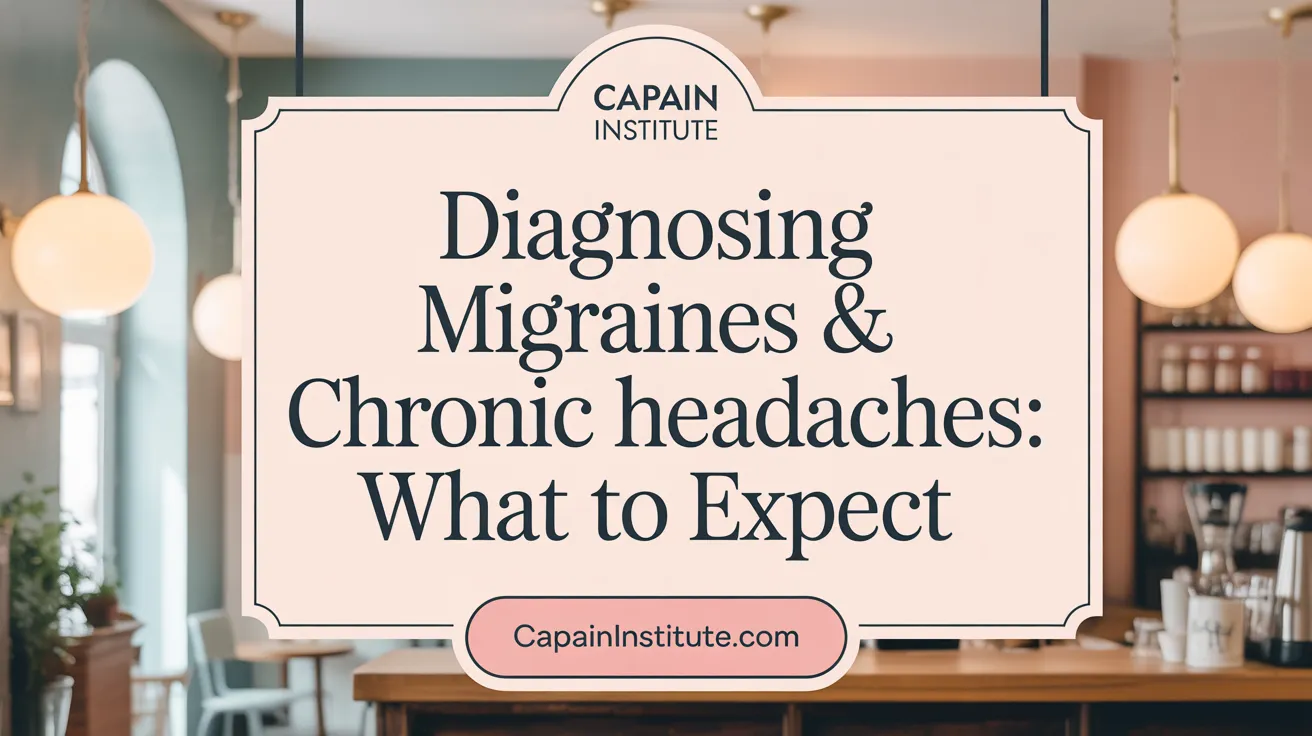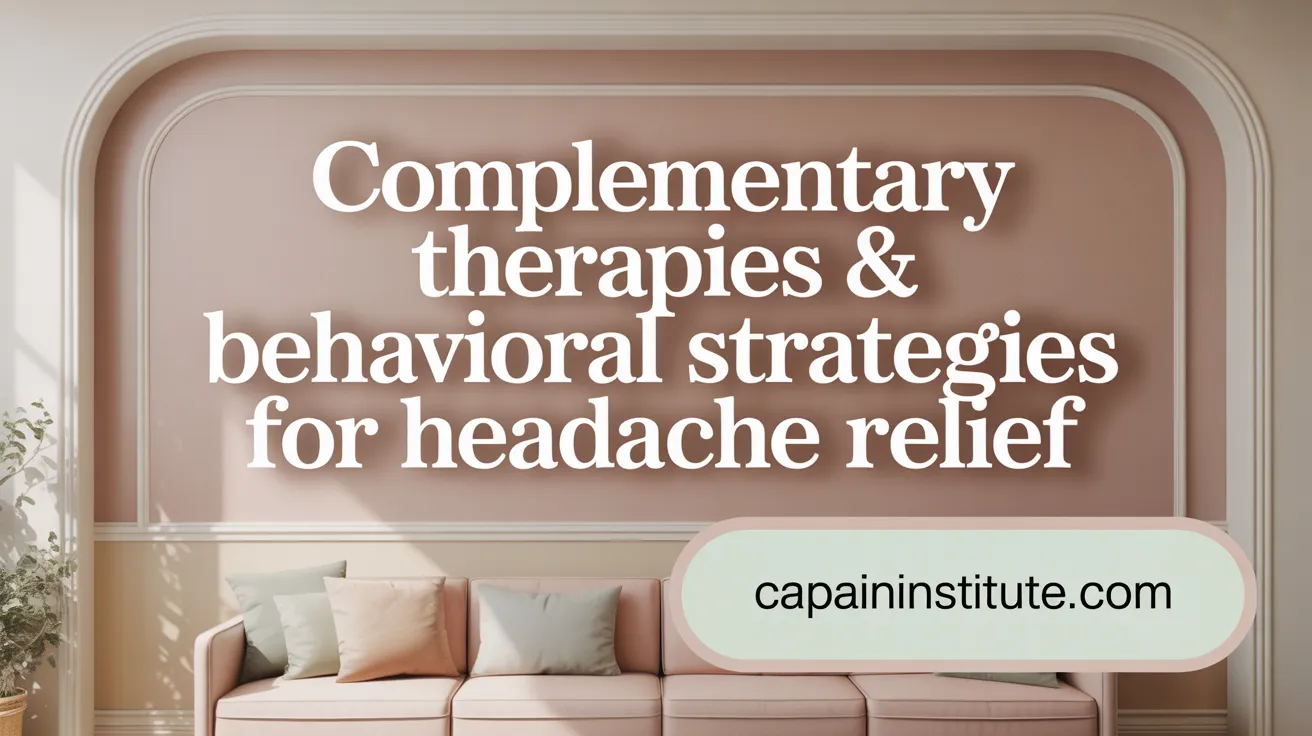Understanding Chronic Headaches and Migraines
Chronic headaches and migraines affect millions globally, often with profound impacts on daily life. Effective management requires a multifaceted approach encompassing diagnosis, medical and non-medical treatments, lifestyle changes, and ongoing self-care. This article delves into the causes, diagnosis, and diverse strategies to control these disabling conditions, empowering readers with evidence-based insights and practical advice.
Causes, Triggers, and Symptoms of Chronic Headaches and Migraines

What are the common causes, triggers, and symptoms of chronic headaches and migraines?
Chronic headaches and migraines develop from a mix of genetic factors, neurological dysfunction, and environmental influences. A person’s genetic makeup can predispose them to migraine, especially if there’s a family history of the condition. This hereditary aspect means that if a close relative has migraines, an individual is more likely to experience them.
Neurologically, migraines involve abnormal nerve signaling, imbalances in brain chemicals such as serotonin, and malfunctions in pain processing centers. These disturbances result in the characteristic symptoms of migraines, including intense, throbbing, or pulsatile head pain. The pain is usually unilateral, affecting one side of the head, and can last from hours to days.
Migraine episodes typically follow specific phases: the prodrome, aura, headache, and postdrome. The prodrome may include symptoms like mood changes, fatigue, and increased hunger. Aura involves visual disturbances, such as flashes of light or zigzag lines, or sensory changes like tingling. The headache phase involves moderate to severe pain, often worsened by physical activity, accompanied by nausea, sensitivity to light and sound. The postdrome leaves many feeling exhausted or disoriented.
Common triggers are environmental, behavioral, and lifestyle factors. Stress and hormonal fluctuations—particularly in women—are significant contributors. Dehydration, skipped meals, and certain foods like aged cheese, processed meats, and alcohol (especially red wine) can provoke attacks. Sleep irregularities, weather changes, exposure to bright or flickering lights, strong odors, and medication overuse also play considerable roles. For detailed insights on triggers and causes, see Migraine causes and impact and Lifestyle Changes for Migraine Management.
Recognizing these symptoms and triggers allows for better management and treatment of chronic headaches and migraines, reducing their impact on daily life. For more on diagnosis and treatment options, refer to Diagnosis and Treatment of Chronic Daily Headaches and Migraine Diagnosis and Treatment.
Diagnosis and Assessment of Chronic Headaches and Migraines

How are chronic headaches and migraines diagnosed and assessed by healthcare professionals?
Diagnosing chronic headaches and migraines involves a comprehensive evaluation starting with a detailed medical history. Healthcare providers inquire about the characteristics of the headaches, such as whether they are unilateral, pulsating, last between 4 to 72 hours, and are accompanied by symptoms like nausea, sensitivity to light, and sound. They also evaluate the frequency—at least 15 days per month for at least three months for chronic cases—and investigate any pattern or triggers.
A thorough neurological and physical examination is essential to detect any abnormal signs. The examination aims to rule out secondary causes such as tumors, vascular abnormalities, or infections. Red flags during assessment—such as sudden onset, new neurological deficits, systemic symptoms, or changes in headache pattern—may necessitate further imaging.
Imaging modalities like MRI (preferably with contrast) and CT scans are usually reserved for cases with red flags or atypical features. MRI is more sensitive in detecting secondary causes and vascular issues, while CT can be used for emergency settings.
To support ongoing diagnosis and management, headache diaries or digital symptom-tracking apps are valuable tools. Patients record attack frequency, duration, severity, possible triggers, and medication use. This information aids in differentiating between types of migraines and other headache disorders.
Importantly, assessment includes evaluating medication overuse, which can worsen headaches, known as medication overuse headache (MOH). Addressing MOH involves education about proper medication use and, when necessary, withdrawal.
Overall, diagnosis follows criteria established in the International Classification of Headache Disorders, ensuring accurate categorization—whether episodic or chronic migraine—and guiding appropriate treatment strategies.
Pharmacological Treatments: Acute and Preventive Options

What are the available treatment options for managing chronic headaches and migraines, including medications and therapies?
Managing chronic headaches and migraines involves a combination of medications aimed both at relieving symptoms during an attack and at decreasing the frequency and severity of future episodes.
For immediate relief during migraine attacks, common options include nonsteroidal anti-inflammatory drugs (NSAIDs for migraine) such as ibuprofen and aspirin, which inhibit prostaglandin synthesis. Triptans for migraine including sumatriptan and rizatriptan, are migraine-specific serotonin receptor agonists that constrict blood vessels and block pain pathways. Newer medications such as gepants (ubrogepant, rimegepant) and ditans (lasmiditan) provide alternatives, especially for patients with cardiovascular concerns.
Preventive treatments are designed to reduce attack frequency, severity, and impact on daily life. These include beta-blockers like propranolol and metoprolol, which modulate vascular and neurological pathways involved in migraines. Antiseizure medications such as topiramate and valproate are also effective, reducing nerve excitability and neurotransmitter activity.
Biologic therapies have introduced monoclonal antibodies targeting calcitonin gene-related peptide (CGRP inhibitors), such as erenumab, fremanezumab, and galcanezumab. These are administered via injections at intervals ranging from monthly to quarterly and are particularly beneficial for frequent or chronic migraine sufferers.
Additionally, onabotulinumtoxinA (Botox) is FDA-approved for chronic migraine prevention, injected into specific areas of the head and neck every 12 weeks to inhibit pain signaling.
The choice of medication depends on various factors, including the type and frequency of headaches, patient comorbidities (like cardiovascular disease), side effect profiles, and patient preferences. Treatment often begins with low doses, which are gradually titrated to optimal effect over weeks to months. See medication management for headache prevention for more details.
A key aspect of therapy is avoiding medication overuse, as excessive intake of painkillers can lead to rebound headaches known as medication overuse headache (MOH). Patients are closely monitored, and healthcare providers emphasize the importance of adhering to prescribed doses and schedules.
Recent advances include alternative delivery methods such as nasal sprays and injectable formulations, which can offer rapid symptom relief. These options expand treatment possibilities, providing personalized approaches for different patient needs. For more on acute migraine treatments and evolving therapies.
In addition to medications, several non-pharmacological therapies have demonstrated benefit. These include behavioral therapies such as cognitive behavioral therapy (CBT), biofeedback, relaxation techniques, and acupuncture. Combining lifestyle changes—such as stress management, exercise, adequate sleep hygiene, and dietary modifications—with medications often enhances outcomes.
In summary, pharmacological management of chronic migraines and headaches is multifaceted, combining acute relief with long-term preventive strategies, tailored to individual patient profiles and evolving evidence-based practices.
Non-Pharmacological Therapies and Behavioral Strategies

What are the available treatment options for managing chronic headaches and migraines, including medications and therapies?
Effectively managing chronic headaches and migraines often requires a combination of medication and non-medication approaches. While pharmacological treatments such as preventive medications (beta-blockers, antidepressants, anti-seizure drugs, Botox, and CGRP inhibitors) are central to control attack frequency and severity, non-medication therapies play a vital supportive role.
Cognitive-behavioral therapy (CBT) is a well-supported psychological approach that helps patients develop coping skills to handle stress and reduce headache triggers. It can decrease the frequency and intensity of migraines by addressing maladaptive thoughts and behaviors. Similarly, biofeedback and relaxation techniques, including diaphragmatic breathing, progressive muscle relaxation, and guided imagery, provide patients with tools to regulate physiological stress responses. These methods have demonstrated moderate evidence for reducing both the incidence and severity of headaches.
Emerging treatments involve neuromodulation devices, which deliver electrical or magnetic stimulation to nerves or brain regions involved in pain transmission. Devices such as transcutaneous nerve stimulators and magnetic neuromodulation have shown promising results in reducing migraine days and severity. These non-invasive interventions are especially useful for patients who prefer to avoid long-term medication use or have contraindications.
Acupuncture, another popular alternative, has been shown to reduce migraine frequency and improve pain levels by stimulating specific points on the body. Psychological interventions, including stress management, mindfulness-based therapy, and acceptance and commitment therapy (ACT), contribute to overall well-being and help mitigate the impact of stress-related triggers.
When combined, these therapies can produce a synergistic effect, offering long-lasting benefits by empowering patients with self-regulation skills, reducing reliance on medications, and improving quality of life. Integrating behavioral strategies into a comprehensive care plan enabled by healthcare professionals can significantly enhance treatment outcomes for those with chronic migraines and headaches.
Lifestyle Modifications for Migraine Prevention and Management

What lifestyle modifications and behavioral strategies can help in managing and preventing migraines?
Lifestyle changes form an essential part of effective migraine management, complementing medication and other therapies. Maintaining consistent sleep hygiene is crucial, as irregular sleep patterns or poor sleep quality can trigger migraines. Setting a regular sleep schedule, avoiding screens before bedtime, and creating a comfortable sleep environment can reduce attack frequency (Lifestyle Changes for Migraine Management, Sleep hygiene for migraine).
Regular moderate exercise, such as 30 to 60 minutes of aerobic activity three to five times weekly, helps increase endorphin levels and reduces stress, which can diminish migraine occurrence. Activities like walking, swimming, or cycling are particularly beneficial (exercise benefits for migraine, Physical activity and migraine).
A balanced diet with small, frequent meals rich in protein, fiber, and healthy fats stabilizes blood sugar levels and minimizes fasting-related triggers. Avoiding dietary triggers such as alcohol, caffeine, aged cheeses, processed meats, and artificial additives is recommended. Staying well-hydrated by drinking plenty of water throughout the day is also vital (Dietary modifications for migraine prevention, Hydration and migraines).
Stress plays a significant role in migraines; thus, implementing stress reduction techniques such as mindfulness meditation, yoga, breathing exercises, and progressive muscle relaxation can lower attack frequency and severity (Stress management techniques for migraines, Psychological approaches for migraine management).
Identifying personal migraine triggers through maintaining a headache diary allows individuals to recognize specific factors like certain foods, environmental stimuli, or hormonal changes. Systematic trigger avoidance tailored to individual sensitivities can substantially improve outcomes (Migraine diary and trigger identification, Headache diary for migraine management).
These behavioral strategies work synergistically with medical treatments, empowering patients to take control of their condition, reduce reliance on medication, and improve overall quality of life (Comprehensive migraine treatment plans, Lifestyle modifications for migraine).
Natural Remedies and Complementary Therapies for Headache Relief
What natural remedies and alternative therapies are effective for relieving headache symptoms?
Several natural remedies can help alleviate headache and migraine symptoms. Magnesium supplements for headaches have been shown to reduce the frequency and severity of migraines, especially for those with deficiency. Vitamin B-2 (Riboflavin) for headaches and Coenzyme Q10 and headaches are also popular as supplements that may help prevent attacks.
Herbal options like butterbur and feverfew have been used traditionally and show some evidence supporting their effectiveness, though it is important to discuss their use with a healthcare provider due to possible side effects.
Aromatherapy for headache relief is another supportive approach, particularly using essential oils such as peppermint and lavender. These oils may promote relaxation, ease muscle tension, and reduce the perception of pain when inhaled or applied topically with proper dilution.
Physical therapies including massage therapy for headaches, gentle yoga, and acupuncture for headache relief can be beneficial by relieving muscle tension, reducing stress, and improving circulation. These practices can be especially helpful as part of a comprehensive headache management plan.
However, even natural remedies should be used cautiously. Consulting healthcare professionals before starting any new supplement or therapy is crucial to ensure safety, especially when combining with existing medications or treatments. Proper guidance can help integrate these approaches into an effective, individualized headache management strategy.
The Role of Stress Reduction, Sleep, Diet, and Exercise in Headache Management
How do stress reduction, sleep hygiene, diet, and exercise contribute to headache management?
Stress is a common trigger for various types of headaches, including migraines and tension-type headaches. When stressed, the body reacts through complex neurological and physiological responses, such as increased muscle tension, blood vessel constriction, and hormone release, which can initiate headache episodes.
Effective stress management techniques like mindfulness, cognitive-behavioral therapy (CBT), deep breathing exercises, and relaxation strategies help calm the nervous system, reducing the frequency and severity of headaches. This approach not only diminishes immediate triggers but also enhances overall mental health, contributing to a more resilient nervous system.
Sleep hygiene is also paramount. Irregular sleep patterns, sleep deprivation, or oversleeping can disturb circadian rhythms and provoke migraines or tension headaches. Maintaining a consistent sleep schedule—going to bed and waking up at the same time—creates a restorative sleep cycle essential for brain recovery. Avoiding screens before bedtime, creating a cool, dark, and quiet sleeping environment, and managing sleep disorders like sleep apnea further promote quality sleep that acts as a natural headache preventative (Lifestyle Changes for Migraine Management).
Dietary factors significantly influence headache occurrence. Certain foods and drinks, such as caffeine, alcohol, processed meats, and foods rich in tyramine or MSG, can trigger attacks. Conversely, nutrients like magnesium, omega-3 fatty acids, and riboflavin have been shown to support neurological health, possibly reducing headache frequency and intensity. Eating regular, balanced meals—preferably small, protein-rich, and high in fiber—helps maintain stable blood sugar levels, preventing fasting-related headaches (Nutrition and lifestyle changes improve your headaches).
Regular exercise offers numerous benefits in headache prevention. Moderate aerobic activities like walking, swimming, or cycling increase endorphin production—body’s natural painkillers—that can reduce headache occurrence. Exercise also improves sleep quality, relieves stress, and decreases muscle tension, all of which are protective against migraines and tension-type headaches (6 Tips for Headache Relief).
Integrating these factors into comprehensive care
When combined, stress management, good sleep practices, dietary adjustments, and regular physical activity form a holistic approach to headache management. These lifestyle modifications not only decrease the frequency and severity of headaches but also improve overall health and quality of life.
Healthcare providers often recommend integrating these strategies with medical treatments, including preventive medications, to achieve optimal results (Diagnosis and Treatment of Chronic Daily Headaches). Tailoring interventions based on individual triggers and circumstances maximizes effectiveness. Regular follow-up and education empower patients to make sustainable lifestyle changes that serve as foundational elements of ongoing headache management.
Advances in Research and Evidence-Based Guidelines for Headache Management
Recent developments in headache and migraine management focus on personalized, multidisciplinary strategies supported by robust scientific evidence. The introduction of CGRP monoclonal antibodies (such as erenumab, fremanezumab, and galcanezumab) has revolutionized preventive treatment, offering targeted therapy with fewer side effects for those with chronic migraine. Gepants, a newer class of CGRP receptor antagonists like ubrogepant and rimegepant, have shown efficacy in acute treatment, especially useful for patients with contraindications to triptans, such as cardiovascular risks.
Clinical practice guidelines now emphasize comprehensive assessment, including detailed history, symptom tracking, and trigger identification, to tailor interventions effectively. For example, lifestyle modifications—such as maintaining regular sleep, hydration, diet, and stress management—are strongly supported alongside medications (Lifestyle Changes for Migraine Management).
Evidence also highlights the role of neuromodulation devices, including nerve stimulation and transcranial magnetic stimulation, as viable adjuncts, especially for refractory cases (Neuromodulation Devices for Migraine). Behavioral therapies like cognitive-behavioral therapy, biofeedback, relaxation techniques, and acupuncture have demonstrated benefits in reducing attack frequency and improving quality of life (Psychological approaches for migraine management, Biofeedback and migraine).
Despite these advances, research gaps remain. Comparative studies directly evaluating the long-term safety and efficacy of different biological and pharmacological therapies are limited. Further investigations are needed to refine treatment sequencing, optimize combination therapies, and understand individual variability in response. Additionally, optimizing access to multidisciplinary care and integrating psychological support are crucial future directions to enhance patient-centered outcomes (Comprehensive migraine treatment plans). Collectively, these insights underscore the importance of a comprehensive, evidence-based approach to effectively combat the burden of headache disorders.
Empowering Self-Care and Symptom Tracking in Chronic Headache Management
How can self-care practices and symptom tracking improve the management of chronic headaches?
Implementing self-care routines and maintaining detailed symptom records significantly enhances the management of chronic headaches. Using a headache diary or digital health apps allows patients to identify personal triggers—such as certain foods, stress levels, sleep patterns, or environmental factors—and recognize early warning signs of an upcoming attack. Documenting the frequency, duration, severity, and associated symptoms of headaches, along with medication use, helps tailor individualized treatment plans (headache diary for medical appointments).
Immediate self-management techniques like resting in a dark, quiet room, staying well-hydrated, practicing relaxation exercises (relaxation techniques for headache relief), and applying cold or warm compresses (cold compress for headaches) can provide quick relief during an attack. Sharing comprehensive diary data with healthcare professionals supports more accurate diagnosis, appropriate medication adjustments (Medication management for headache prevention), and the avoidance of medication overuse (Medication overuse in headaches).
This proactive approach empowers patients to take control of their condition, fostering better adherence to treatment strategies and reducing the impact of headaches on daily life. Over time, consistent tracking and self-care help decrease attack frequency and severity, ultimately improving overall quality of life for those living with chronic headaches (Coping strategies for chronic headaches).
Comprehensive Management for Better Outcomes
Managing chronic headaches and migraines requires a holistic approach incorporating accurate diagnosis, effective use of pharmacologic and non-pharmacologic treatments, sustained lifestyle modifications, and active self-care. Advances in medication and behavioral therapies offer promising avenues while empowering patients through education and symptom tracking enhances control. Regular collaboration with healthcare providers ensures individualized, adaptive plans. By addressing triggers, optimizing therapies, and adopting healthy behaviors, individuals can significantly reduce headache frequency and severity, regaining quality of life and productivity.
